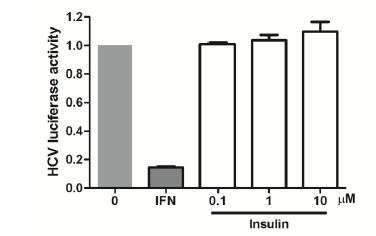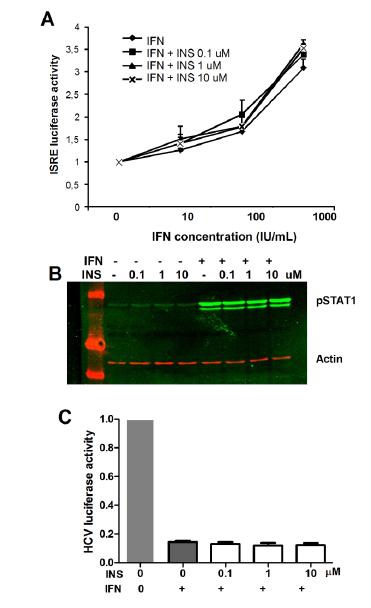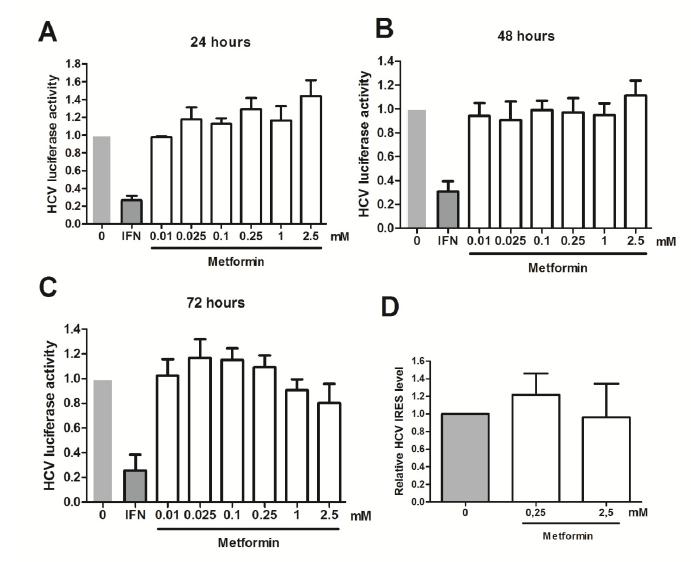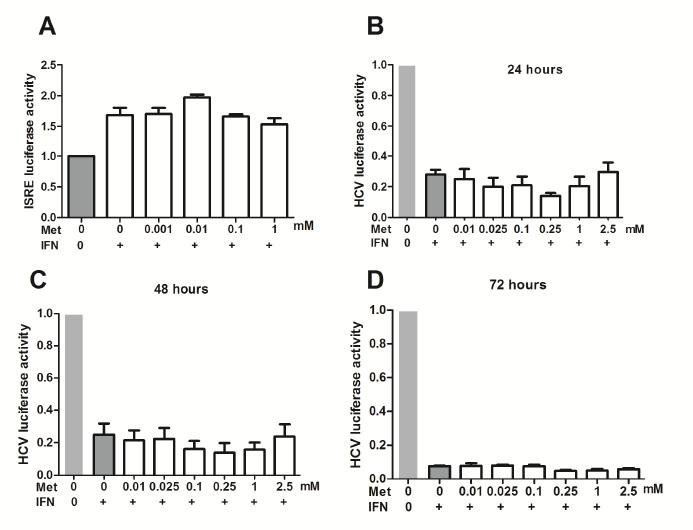Abbreviation list:
AMPK = AMP-activated protein kinase; HCV = hepatitis C virus; HOMA-IR = homeostasis model assessment of insulin resistance index; IFN-α = interferon alpha; INS = insulin; IR = insulin resistance; IRES = internal ribosome entry site; ISRE = interferon stimulated response element; mTOR = mammalian target of rapamycin; PEG-IFN = pegylated interferon; RBV = ribavirin; STAT-1 = signal transducer and activator of transcription 1; SVR = sustained virological response; T2D = type 2 diabetes.
1. Introduction
Chronic hepatitis C virus (HCV) infection is the leading cause of end-stage liver disease worldwide [1]. Sustained virological response (SVR) can be achieved in approximately 50% chronic HCV patients with the current anti-viral standard therapy of pegylated-interferon-alpha in combination with ribavirin (PEG-IFN/RBV). The addition of the recently launched protease inhibitors telaprevir or boceprevir for genotype 1-infected patients has increased the response rate by 25% [2,3]. However, in sub-group of patients, the response rate to PEG-IFN/RBV treatment can be negatively influenced by other factors, such as metabolic syndrome and insulin resistance (IR) [4], calling for novel therapeutical avenues for these subgroups of patients.
HCV infection may promote the development of IR in the infected patients [5]. HCV infection is also associated with a risk of type 2 diabetes (T2D) [6,7]. Chronic HCV patients who develop IR or T2D have a decreased response rate to the PEG-IFN/RBV treatment [8,9,10,11]. In two randomized clinical trials, it has been shown that adding metformin to PEG-IFN/RBV therapy increased SVR rate as compared to the standard PEG-IFN/RBV therapy alone in chronic HCV patients infected with genotype 1 and IR. Insulin sensitivity, as measured by the homeostasis model assessment of insulin resistance index (HOMA-IR) greater than 2, was also improved, suggesting that it may be associated with the likelihood of achieving SVR [12,13]. However, in Romero-Gomez et al. study [12], a significant increase in SVR rate was only observed in female patients. These findings raise questions of whether metformin may have direct anti-HCV effect or may improve the anti-viral action of interferon.
Another class of anti-diabetic drugs, insulin (INS), has been reported to interfere with interferon signaling in cell culture. Upon interferon-alpha stimulation, INS was reported to reduce the expression of several interferon-stimulated genes (ISG), such as double-stranded RNA (dsRNA)-dependent protein kinase (PKR), myxovirus resistance protein A (MxA) and 2’-5’ oligoadenylatesynthetase 1 (OAS-1) [14]. These findings suggest that hyperinsulinaemia induced by IR may inhibit the anti-viral effect of interferon and lead to decreased SVR rate. However, whether this interference affects the overall anti-HCV effect of interferon is not known.
Insulin and metformin both target nutrional signaling through mammalian target of rapamycin (mTOR) pathway [15]. Control of cellular metabolism is essentially similar for all eukaryotes studied and involves the integration of cellular nutritional status and anabolic survival signaling [16]. Nutritional status is sensed through AMP-activated protein kinase (AMPK) and inhibits mTOR. AMPK activity is directly stimulated by metformin [17]. Anabolic signals like insulin, in contrast, stimulate mTOR. The cardinal importance of nutritional signal transduction in human cell biology begs the question as to the role of this pathway in the control of HCV replication.
In the current study, we investigated the effects of insulin and metformin on HCV infection as well as on anti-viral interferon response using the sub-genomic replicon and JFH1-derived full-length infectious models. However, we found that neither insulin nor metformin affect HCV infection or the anti-HCV action of interferon, suggesting that HCV replication is largely independent of cellular nutritional signaling.
2. Materials and Method
2.1. Cell Culture and HCV Models
HCV subgenomic replicon model (Huh7-ET) was based on Huh7 cells containing a subgenomic HCV bicistronic replicon (I389/NS3-3V/LucUbiNeo-ET) [18]. As an infectious HCV model, Huh7.5.1 cells harboring the full-length JFH1-derived genome was used [19]. Stable luciferase expressing cells were generated by transducing naïve Huh7 cells with a lentiviral vector expressing the firefly luciferase gene (LV-PGK-Luc). Cells were maintained in complete DMEM (cDMEM) containing 10% v/v fetal calf serum, 100 IU/mL penicillin, 100 g/mL streptomycin and 2 mM L-glutamine. The Huh7-ET cells were maintained with 250 g/mL G418. Viral replication of Huh7-ET was monitored by measuring luciferase activity. qRT-PCR was used to quantify cellular HCV RNA for the infectious model.
2.2. Interferon Signaling Reporter Assay
As a model for interferon responses, we used a LV transcriptional reporter system expressing the firefly luciferase gene driven by a minimal CMV basal promoter containing multiple ISREs. The HCV permissive Huh7 cells were transduced with LV-ISRE-Luc to create a stable reporter cell line. Transduced cells were plated in 96-well multiplates and the luciferase activity was measured.
2.3. Western blot
Proteins in cell lysates was heated 5 min at 95 ℃ followed by loading onto a 15% sodium dodecyl sulfate-polyacrylamide SDS gel and separating by electrophoresis (SDS-PAGE). After 90 minutes running in 115 V voltage, proteins were electrophoretically transferred onto a polyvinylidene difluoride (PVDF) membrane (Invitrogen) for 1.5 hour with an electric current of 250 mA. Subsequently, the membrane was blocked with 2.5 mL blocking buffer and 2.5 mL PBS containing 0.05% Tween 20 (PBS-T). It was followed by incubation with primary antibody overnight at -4 ℃. Membrane was washed 3 times followed by incubation for 1.5 h with an peroxidase conjugated secondary antibody (1:5,000). After 3 times washing, protein bands were detected with odyssey 3.0 infrared imaging system.
2.4. Statistical Analysis
Statistical analysis was performed by using nonparametric test (Mann-Whitney test) with the Graphpad Prism software. P-values less than 0.05 were considered as statistically significant.
3. Results
3.1. Insulin does not affect HCV replication.
We used sub-genomic HCV replicons to examine the effect of INS on HCV replication. As shown in Figure 1, 24 hours treatment of Huh7-ET replicon cells with IFN-α significantly reduced the HCV internal ribosome entry site (IRES)-driven luciferase activity, indicating the potent anti-HCV effect of IFN-α. Treatment of Huh7-ET replicon cells with increasing doses of INS, however, did not affect IRES-driven luciferase activity, suggesting that INS did not influence HCV replication.
3.2. Insulin does not interfere with anti-viral interferon response.
To investigate whether INS interferes with interferon signaling, we studied the effect of INS on interferon response in Huh-7 cells. It is known that interferon regulate the expression of most ISGs by inducing ISRE promoter element [20]. To investigate whether INS can interfere with the ISRE-driven transcription, we used a lentiviral transcriptional reporter system expressing the firefly luciferase gene driven by a promoter containing multiple ISREs (LV-ISRE-Luc). As shown in Figure 2A, stimulation with IFN-α resulted in induction of ISRE-regulated luciferase activity in a dose dependent manner. Combined treatment with IFN-α and INS did not impair ISRE-regulated luciferase activity. Interferon stimulation activates the phosphorylation of signal transducer and activator of transcription (STAT)-1 protein, one of the key signaling molecules induced by interferon [20]. We investigated the phosphorylation of STAT-1 by Western-blotting analysis. Figure 2B showed that STAT-1 phosphorylation was not impaired in Huh-7 cells by treatment of INS in addition to IFN-α.
We further investigated whether INS may influence the anti-viral effect of interferon by combined treatment of Huh7-ET replicon cells with IFN-α and increasing doses of INS. Figure 2C showed that increasing doses of INS did not have an impact on anti-viral effect of IFN-α.
3.3 Metformin does not affect HCV infection.
To study the effects of metformin on HCV, both subgenomic and infectious models were used. Figure 3A shows that 24 hours treatment of Huh7-ET replicon cells with IFN-α significantly reduced the HCV IRES-driven luciferase activity, as shown previously in Figure 1. Treatment of Huh7-ET replicon cells with increasing doses of metformin, however, did not affect IRES-driven luciferase activity, suggesting that metformin does not affect HCV replication. We confirmed this finding in JFH1-derived infectious model that metformin treatment did not influence HCV RNA levels as measured by quantitative PCR (Figure 3B).
3.4. Metformin does not interfere with anti-viral interferon response.
We first explored the potential effect of metformin on interferon signaling. As shown in
Figure 4A, treatment of metformin does not interfere with ISRE-regulated luciferase activity induced by IFN-α. We further explored the possibility that metformin can influence the anti-viral action of interferon by combined treatment of Huh7-ET replicon cells with IFN-α and increasing doses of metformin. Figure 4B shows that combination of IFN-α and increasing doses of metformin did not have an impact on the anti-viral effect of IFN-α.
4. Discussion
IR is a state in which cells fail to respond to the action of insulin and several molecular pathways are involved in the pathogenesis of IR [21]. IR is a known risk factor for the development of T2D [22]. HCV may promote IR directly via HCV core protein-mediated degradation of insulin receptor substrate 1 (IRS-1) or indirectly via induction of inflammatory cytokines which inhibit insulin signaling such as tumor necrosis factor α (TNF-α) [5,23]. It seems that induction of IR may favor the virus persistence since it is clinically associated with decreased response to PEG-IFN/RBV therapy [8,10,11]. The pancreatic islet responds to compensate the presence of IR by increasing insulin secretion, leading to hyperinsulinaemia [24].
A significantly reduced response to PEG-IFN/RBV therapy in chronic HCV patients with IR (HOMA-IR ≥ 3) was already observed within 24 hours after the first administration of the drugs, as indicated by a substantially lower decline in serum HCV-RNA levels [25]. In a previous study by Franceschini et al. [14], it was suggested that insulin may impair interferon signaling by decreasing IFN-α-induced gene expression of PKR, MxA and OAS-1 which mediate the anti-viral action of IFN-α. These findings may explain the reduced response of HCV patients with a concomitant state of hyperinsulinaemia to PEG-IFN/RBV therapy. However, they did not provide any evidence whether the decreased responses to interferon signaling may negatively affect the overall anti-viral action of interferon. It is known that interferon pathway induces hundreds of ISGs in the responding cells [26]. In this study, we addressed this issue by using sub-genomic HCV model mimicking viral replication as an important model in understanding HCV biology and anti-viral action of interferon [27]. In this model, we demonstrated that insulin alone did not influence HCV replication. Furthermore, in contrast to previous report [14], we demonstrated that insulin did not affect the signaling transduction as well as the potent anti-HCV action of IFN-α. However, the HepG2 cell line that is not permissive for HCV infection was used by the previous study [14]. We thus can’t fully exclude whether this discrepancy might be due to different modeling systems.
Metformin is an oral anti-hyperglycaemic agent and one of the most widely prescribed anti-diabetic agents in the clinic. Metformin exerts its effect by reducing insulin resistance and inhibiting gluconeogenesis in the liver, mainly through AMP-activated protein kinase (AMPK)-dependent pathway [17]. It was suggested that metformin may enhance the anti-viral activity of PEG-IFN/RBV therapy. In chronic HCV patients with IR state, there was an improved SVR rate in patients receiving metformin in addition to the standard PEG-IFN/RBV therapy [12,13]. The improved SVR rate may be associated with an increased sensitivity to insulin, as indicated by a significant decline in HOMA-IR index in patients receiving metformin [12,13]. This suggests that, in contrast to the proposed model by Franceschini et al. [14], insulin signaling in some extent may help the anti-viral activity of interferon. Indeed, our study showed that insulin modestly increased the ISRE-driven luciferase activity, even though this was not statistically significant. Our study showed that metformin has no direct effect on the anti-viral activity of interferon. However, we can not rule out the possibility that metformin can act through other mechanisms, such as via immunomodulatory pathways. It was suggested that metformin treatment in breast cancer patients may stimulate the anti-tumor immunity [28].
HCV has been shown to upregulate Beclin1 for induction of autophagy and activates mTOR signaling [29]. Additional evidence showed that HCV could activate the mTOR/S6K1 pathway by IRS-1 function inhibition and perturb glucose metabolism via downregulation of GLUT4 and upregulation of PCK2 for insulin resistance [30]. Although insulin and metformin have opposite effects on nutritional signaling through mTOR, it appears that treatment of these compounds are still not sufficient to affect HCV infection. This observation is of relevance in view of the large number of HCV patients that receive rapalogs (that also target mTOR) following orthotopic liver transplantation, but requires direct validation. Experiments addressing this important question are currently under progress in our laboratory.
5. Conclusion
Our study demonstrated that insulin and metformin do not have direct interaction with HCV infection or anti-viral interferon response. Conceivably, the potential impact of anti-diabetic medications on the responsiveness of chronic hepatitis C patients to interferon therapy could via indirect mechanisms, which absolutely deserve further elaboration.
Acknowledgements
The authors thank the Netherlands Organization for Scientific Research for financial support of a VENI grant (No. 916-13-032) (to Pan, Q.) and the European Association for the Study of the Liver for a Sheila Sherlock Fellowship (to Pan, Q.). Hakim, MS is supported by Infection and Immunity (I&I) Fund, The Postgraduate School Molecular Medicine, Erasmus MC, Rotterdam. The authors also thank the China Scholarship Council for funding PhD fellowship to Wang, Y. (201207720007) and Zhou, X. (No. 201206150075).
Conflict of Interest
All authors declare no conflict of interest in this paper.










 DownLoad:
DownLoad: 









